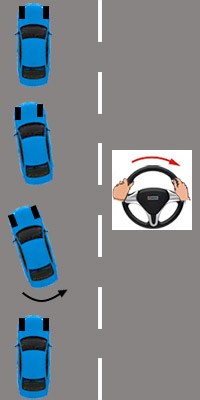Skidding is more likely to occur when there is ice, snow or water on the road. However, it is important to remember that most skidding is a result of bad driving. A car will only skid if it is being driven at an inappropriate speed or if provoked to do so by aggressive steering, braking or acceleration.
To prevent skidding, you should never ask your car to do more than it can do with the grip available. As a result, in poor weather conditions, you should:
Your car is more likely to skid when the road is icy or covered in snow. In such conditions to avoid skidding, you should slow right down. You should also steer and brake very gently. Your stopping distance should also be increased by up to ten times greater than in normal conditions.
When driving in winter, and especially on a winter's evening when the sky is clear, you should look out for ice forming on the road. For early warning signs, look to see if ice is forming on the windows of parked cars.
You should be extra careful when travelling on an exposed road such as a motorway bridge. Ice will often form here first. If your car has an outside temperature meter then keep a close eye on it.
In freezing conditions beware of rain. This can form black ice, which lies invisible on the road. Black ice isn't black it is transparent. Hence its notoriety as a driving hazard.
In icy conditions, your steering may start to feel lighter. Tyre noise may also decrease. If this happens then you are likely to be driving on ice. To prevent a dangerous skid lift your foot gently off the accelerator. This will allow your car to slow smoothly and gently. If you need to continue driving then do so slowly using a high gear. This will help you avoid hard acceleration, which could spin the wheels.
Accelerating too hard can also cause skidding. If you accelerate too hard when moving off on a slippery road then the driven wheels will spin without propelling the car forward. In icy conditions, some wheel spin may be inevitable. To minimize the spin try engaging a higher gear.
Braking hard on a slippery road can also cause your car to skid. Your wheels can lock up and you will continue onwards with little or no braking effect. The locked wheels will also prevent you from steering. If this happens you should release the brake pedal to free the wheels then reapply the brake less harshly. If your car has ABS fitted then your wheels won't lock. However, don't think ABS eases all problems when driving on a slippery road. It doesn't.
On a slippery road if you approach a corner too quickly there is a good possibility that your car will skid. This is even more likely if you also brake harshly whilst taking the corner. You turn the steering wheel to corner but there is no response and the car continues on ahead. This is a classic front-wheel skid. If this happens,
